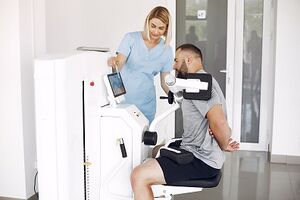Isokinetic Exercise
Introduction[edit | edit source]
Isokinetic exercise or accommodating variable-resistance exercise, is a type of therapeutic exercise which refers to force exertion against the isokinetic machine that leads to limb movement at a fixed velocity. [1] In other words, it corresponds to exercises whose limb velocity remain stable throughout the range of motion, and thus, muscle force and resistance in the machine are changing to meet this requirement. [1]
Types of Isokinetic Exercise[edit | edit source]
Isokinetic exercises may be concentric-concentric, concentric-eccentric, or eccentric-eccentric.[1]
Isokinetic Assessment[edit | edit source]
Isokinetic machines can be used in movement assessment and assessment of muscle strength providing objective as well as quantitative measurements.
Control of speed in movement assessment may provide valuable insights on individual dynamic muscle patterns while providing stability to the testing positions. [2]
Muscle strength can be assessed by providing resistance by an isokinetic dynamometer throughout the range of motion at a constant velocity. This generates an isokinetic torque curve, whose highest point indicates strength of a muscle or muscle group of the targeted joint. Muscle strength can also be evaluated across differing speeds, and ranges of motion making this a useful tool for comparing the left to right side.
Assessment of isokinetic eccentric movement can be performed either by (1) setting up a predetermined load and having the lever arm drive the extremity at the predetermined velocity, or (2) working against a passively moving lever arm at the predetermined velocity. [2]
A prerequisite of high reliability of isokinetic testing is to follow the testing protocol. Collected data is in a machine-specific format and different data handling software programmes are used for different machines. [2] Thus, users need to be familiar with this type of data analysis and interpretation, which does not necessarily reflect functional patterns of performance.
References[edit | edit source]
- ↑ 1.0 1.1 1.2 Dale B. Principles of rehabilitation. In: Andrews J, Harrelson G, Wilk K. (eds) Physical Rehabilitation of the Injured Athlete. 4th ed. 2012, 41-66. Available from: https://www.sciencedirect.com/science/article/abs/pii/B9781437724110000046 [accessed 8/7/2023]
- ↑ 2.0 2.1 2.2 Wilk K, Reinold M, Andrew J. The Athlete's Shoulder. 2nd ed. 2009. Available from: https://www.sciencedirect.com/book/9780443067013/the-athletes-shoulder [accessed 8/7/2023]







